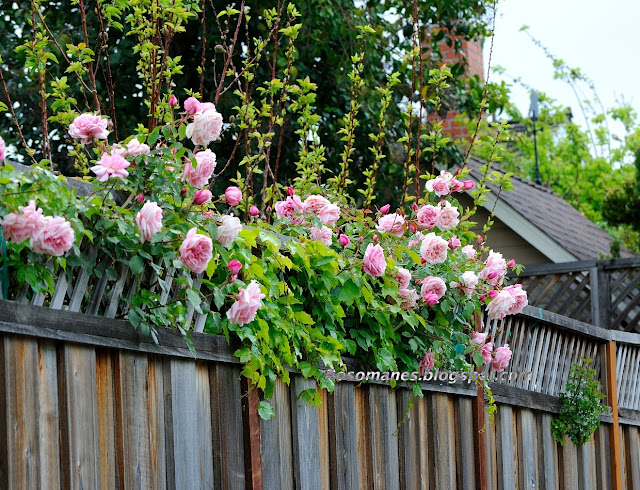 |
| Rosette Delizy (Tea, Nabonnand, 1922) in my garden |
Rose classification can sometimes be confusing, especially where antique roses are concerned, so I thought I would point out a few differences between hybrid tea (modern) and tea (old) roses.
A picture is worth a thousand words, so here are two photos for comparison (below).
Hybrid Tea:
 |
| Ville de Paris (Hybrid Tea, Pernet-Ducher, 1925) at the San Jose Heritage Rose Garden (the Heritage) |
Tea:
 |
| Mrs. Dudley Cross (Tea, Paul and Son, 1907) at the Heritage |
What you might notice is a stiffer upright growth habit of a hybrid tea, and its brighter, more "modern" color. Teas are bushy, well-branched shrubs with pastel colored blooms that often look down.
 |
| Maman Cochet (Tea, Cochet, 1892) at the Heritage |
Tea roses were imported from China at the beginning of the 19th century. They were called Tea roses because they have a fragrance reminiscent of tea leaves.
 |
| 'Alexander Hill Grey' (Tea, found) at the Heritage |
Tea roses have some of the most sumptuous, elegant and delicately colored blooms in the rose world...
 |
| Mrs. Dudley Cross at the Heritage |
...which are also quite susceptible to weather damage, such as balling and spotting.
 |
| Rubens (Tea, Robert, 1959), with outer petals ruined by spotting, a very common occurrence with this cultivar (at the Heritage) |
Tea rose blooms are "weak-necked", or nodding,...
 |
| Mrs. Dudley Cross at the Heritage |
...which can be great in a landscape, especially for climbers (as you want your roses to look at you rather than up into the sky).
 |
| A cane of climbing White Maman Cochet (Climbing Tea, Knight andSons, 1907) over my head (at the Heritage) |
While teas were graceful landscape shrubs...
 |
| 'Curtiss Ave. Yellow Tea 31' (Tea, found) at the Heritage |
...their blooms (being weak-necked and weather-damaged) were not ideal for rose shows which became popular in the 19th century, or for cutting.
 |
| Catherine Mermet (Tea, Guillot fils, 1869) at the Heritage |
At the time, hybrid perpetuals were the rose of choice for that purpose. They had the necessary stiff canes but lacked the refined high center of teas.
 |
| 'Spiny HP' (Hybrid Perpetual, found) at the Heritage |
They also came in "classic" colors of pink, purple and white, lacking the subtle apricots and creamy yellows of teas.
 |
| Géant des Batailles (Hybrid Perpetual, Nérard, 1845) at the Heritage |
The obvious solution was to cross these two classes, which resulted in the creation of a hybrid tea. Hybrid Teas are florist roses, and it is these roses that you buy in bouquets. They were bred for long cutting stems, and were not originally meant to be grown as a landscape shrub. It is their tendency to create these long stems that gave them their unkind description of "lollipops on sticks", or "soldiers on parade".
 |
| April in Paris (Hybrid Tea, Zary, 2007) in my garden |
Because of their popularity with rosarians and gardeners, hybrid teas were more and more extensively hybridized, resulting in plants that resembled less and less the antique teas.
 |
| Captain Harry Stebbings (Hybrid Tea, discovered by Stebbings, 1980) at the Heritage |
As the public became more demanding, hybrid teas developed more and more unusual colors....
 |
| Singin' In The Rain (Hybrid Tea, Floribunda, McGredy, 1994) at the Heritage |
....and some really weird shapes:).
 |
| Meilland Decor Arlequin (Shrub, Meilland, 1986), looking unusually ruffled (at the Heritage) |
After saying all this, I don't mean to create an impression that I don't like hyrbid teas. I do, and grow quite a few.
 |
| Comtesse de Provence (Hybrid Tea, Meilland, 2001) in my garden |
These roses can have a place in the garden too. They are very good for cutting, and lots of them are really fragrant too. Their sparse awkward growth habit is a great excuse to grow some perennials or herbs at their base, and if you have a narrow planting bed, nothing will work better.
 |
| Double Delight (Hybrid Tea, Swim, 1977) in my garden with lots of pelargoniums |
Finally, nothing is quite as clear-cut as I have said so far :). Hybrid Teas are modern roses with quite a distinct set of genes from the original teas, but sometimes they do resemble each other. Many hybrid teas come in pastel colors, and quite a few have heavy petalled blooms that manage to bend down even their sturdy long stems :).
 |
| Golden Oldie (Hybrid Tea, Davidson, unknown) at the Heritage |
Well grown, hybrid teas do not have to sport naked legs, and stiffly upright blooms all at the top.
 |
| High Noon (Hybrid Tea, climbing, Lammerts, 1946) at the Heritage |
On the other hand, some tea rose blooms can hardly be described as softly colored:)
 |
| Niles Cochet (Tea, discovered by California Nursery Co., 1906) at the Heritage |
But still, antique teas will remain my favorite for the exquisite soft colors, muddled heavy petalled blooms, and, of course, the tea fragrance.
 |
| White Maman Cochet (Tea, Cook, 1896) at the Heritage |
























































